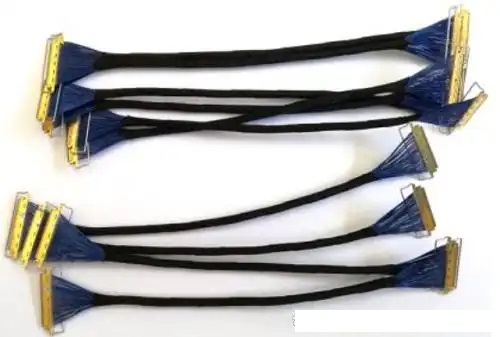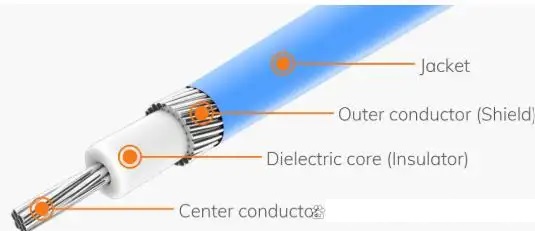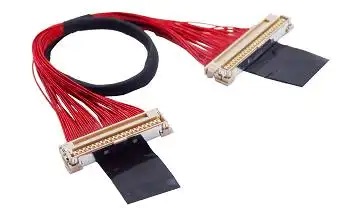In modern consumer electronics, medical equipment, automotive electronics, and high-definition signal transmission devices, there is a seemingly unremarkable type of wire material—the ultra-thin coaxial cable (Micro Coaxial Cable)—which quietly supports the high-performance operation of devices. Don't look at its slenderness like hair, the internal structure and material combination are very demanding. These "small" differences determine the signal quality, stability, and lifespan of the entire cable assembly. Today, let's delve deeper into: How demanding is the material selection for ultra-thin coaxial cable assemblies?

What is a micro coaxial cable (Micro Coaxial Cable)?
In simple terms, a super-fine coaxial cable is a type of coaxial cable with an extremely small diameter (about 0.2mm~1.2mm), compact in structure, and capable of carrying high-frequency signals.
It is widely used in the internal components of high-density devices such as smartphone display modules, laptop screen cables, medical endoscopes, drone cameras, and handheld tripods.
Core characteristics:
Strong anti-interference capability
• Fast signal transmission speed
Excellent bending performance
Small in size, saving space

Basic Structure of Ultra-Fine Coaxial Cable
A complete ultra-thin coaxial cable is usually composed of four layers: Inner Conductor → Insulation → Shielding → Jacket, and the material selection for each layer will have a critical impact on the performance of the entire cable assembly.

Three, the material is meticulous in layer-by-layer decomposition
Inner conductor material
Responsible for signal transmission, it is the "information channel" of the entire line.
Common materials:
• 裸铜 (Bare Copper): Excellent electrical conductivity, moderate price.
• Silver-Plated Copper: Offers superior high-frequency performance and strong anti-oxidation ability, commonly used in high-end medical and imaging equipment.
Tinned Copper (Tinned Copper): Cost-effective, good for welding, suitable for general application scenarios.
High-frequency imaging and medical-grade equipment commonly use silver-plated copper, while mobile phones and laptop camera modules often opt for bare copper.
Insulating material
Isolation of signals, prevention of leakage, and enhancement of signal stability.
Common materials:
• FEP (fluorinated ethylene propylene): Resistant to high temperatures, flame retardant, and has a low dielectric constant, suitable for high-frequency applications.
PFA (perfluoroalkoxy ethylene): Excellent high-frequency characteristics, strong resistance to chemical corrosion.
• PE (polyethylene): High cost-performance ratio, suitable for general environments.
In the high-frequency field, FEP is the preferred choice; while PE can be used for general electronic devices to control costs.
③ Shielding layer material
Function: Shield against external electromagnetic interference (EMI), ensuring pure signal.
Common forms:
Silver-plated copper woven mesh
Tin-plated copper woven mesh
Copper foil + woven composite structure
For high-definition signal transmission and medical imaging equipment, the anti-interference effect of silver-plated copper braided + aluminum foil composite shielding layer is the most ideal.
④ Outer sheath material
Function: Protect the internal structure, enhance the wear resistance, bending resistance and environmental adaptability of the cable.
Common materials:
TPU (Thermoplastic Polyurethane): soft, wear-resistant, and environmentally friendly, suitable for fine wire cables.
• FEP: High temperature resistance, chemical corrosion resistance, suitable for harsh environments.
PVC (Polyvinyl Chloride): Economical and practical, meeting general usage requirements.
If you prioritize flexibility and environmental protection, it is recommended to choose TPU; in high-temperature environments, FEP is recommended.

Why is the material of ultra-fine coaxial cables so important?
Signal transmission performance: The quality of the conductor and insulating layer determines the transmission speed and signal loss.
Interference resistance: The shielding layer structure affects the stability of equipment operation.
Environmental resistance: The material's high-temperature resistance and corrosion resistance are related to the product's lifespan.
Processing performance: Softness and weldability affect production efficiency and yield rate.

Extremely thin coaxial cables, although tiny in size, are the key connecting components behind many high-performance devices. Different application scenarios, signal frequency bands, and environmental requirements determine the different combinations of conductors, insulators, shields, and sheaths. It is these seemingly "insignificant" details that lay the foundation for the stable and efficient operation of the intelligent devices we rely on in our daily lives.
I am Kunshan Jie Kang Fu Precision Electronics, focusing on the design and customization of high-speed signal cables and ultra-thin coaxial cables for a long time, committed to providing stable and reliable high-speed interconnect solutions. If you have any related needs or want to learn more, please contact: Manager Zhang.
18913228573 (WeChat number).




